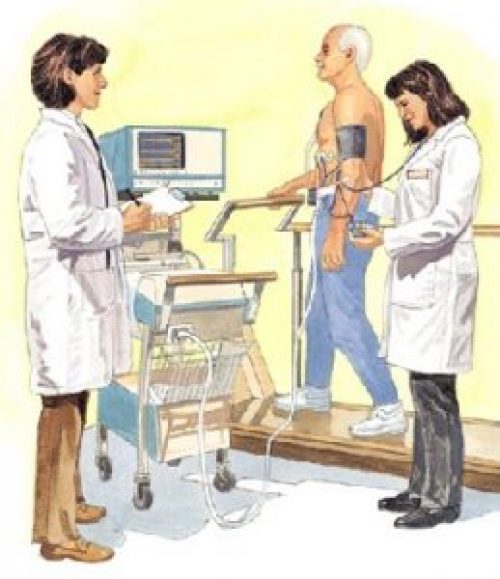A stress test, also called an exercise stress test, gathers information about how your heart works during physical activity. Because exercise makes your heart pump harder and faster than usual, an exercise stress test can reveal problems within your heart that might not be noticeable otherwise.
An exercise stress test usually involves walking on a treadmill or riding a stationary bike while your heart rhythm, blood pressure and breathing are monitored.
Your doctor may recommend an exercise stress test if he or she suspects you have coronary artery disease or an irregular heart rhythm (arrhythmia). The test may also be used to guide your treatment if you’ve already been diagnosed with a heart condition.
Your doctor may recommend an exercise stress test to:
Diagnose coronary artery disease. Your coronary arteries are the major blood vessels that supply your heart with blood, oxygen and nutrients. Coronary artery disease develops when these arteries become damaged or diseased — usually due to a buildup of deposits containing cholesterol and other substances (plaques).
Diagnose heart rhythm problems (arrhythmias). Heart arrhythmias occur when the electrical impulses that coordinate your heart rhythm don’t function properly, causing your heart to beat too fast, too slowly or irregularly.
Guide treatment of heart disorders. If you’ve already been diagnosed with a heart condition, an exercise stress test can help your doctor find out how well treatment is working. It may also be used to help establish the treatment plan for you by showing how much exercise your heart can handle.
In some cases, stress tests may be used to help determine the timing of cardiac surgery, such as valve replacement. In some people with heart failure, results from a stress test may help the doctor evaluate the need for heart transplantation or other advanced therapies.
Your doctor may recommend a test with imaging, such as a nuclear stress test, if a routine exercise stress test doesn’t pinpoint the cause of your symptoms.
Risks
An exercise stress test is generally safe, and complications are rare. But, as with any medical procedure, it does carry a risk of complications.
Potential complications include:
Low blood pressure. Blood pressure may drop during or immediately after exercise, possibly causing you to feel dizzy or faint. The problem should resolve after you stop exercising.
Abnormal heart rhythms (arrhythmias). Arrhythmias brought on by an exercise stress test usually go away shortly after you stop exercising.
Heart attack (myocardial infarction). Although exceedingly rare, it’s possible that an exercise stress test could provoke a heart attack.


How You Prepare
You may be asked not to eat, drink or smoke for two hours or more before an exercise stress test. Ask your doctor if you should avoid caffeine or certain medications the day before the test, because they can interfere with certain stress tests. Otherwise, you can take your medications as usual.
If you use an inhaler for asthma or other breathing problems, bring it with you to the test. Make sure your doctor and the health care team member monitoring your stress test know that you use an inhaler.
Wear or bring comfortable clothes and walking shoes to the exercise stress test.
What you can expect
When you arrive for your exercise stress test, your doctor asks you about your medical history and how often you usually exercise. This helps determine the amount of exercise that’s appropriate for you during the test.
During an exercise stress test
A nurse or technician places sticky patches (electrodes) — which are connected by wires to an electrocardiogram (ECG or EKG) machine — on your chest, legs and arms to record your heart’s electrical signals. A cuff on your arm checks your blood pressure during the test. You may be asked to breathe into a tube during the test to determine how well you breathe during exercise.
You then begin walking on the treadmill or pedaling the stationary bike slowly. As the test progresses, the speed and incline of the treadmill increases. You can use the railing on the treadmill for balance, but don’t hang on tightly, as that may skew the results of the test. On a stationary bike, the resistance increases as the test progresses, making it harder to pedal.
You continue exercising until your heart rate has reached a set target or until you develop symptoms that don’t allow you to continue. These signs and symptoms may include:
Moderate to severe chest pain
Severe shortness of breath
Abnormally high or low blood pressure
An abnormal heart rhythm
Dizziness
Certain changes in your electrocardiogram
You may stop the test anytime you’re too uncomfortable to continue exercising.
After an exercise stress test
After you stop exercising, you may be asked to stand still for several seconds and then lie down for about five minutes with the monitors in place so that they can continue taking measurements as your heart rate and breathing return to normal.
When your exercise stress test is complete, you may return to your normal activities for the remainder of the day.
Results
If the information gathered during your exercise stress test shows your heart function to be normal, you may not need any further tests.
However, if the results are normal and your symptoms continue or become worse, your doctor may recommend that you have a nuclear stress test or another exercise stress test that includes an echocardiogram before and after exercise. These tests are more accurate and provide more information about your heart function, but they are also more expensive.
If the results of your exercise stress test suggest coronary artery disease or reveal an arrhythmia, the information gathered during the test will be used to help your doctor develop a treatment plan. You may need additional tests and evaluations, such as a coronary angiogram, depending on the findings.
If the purpose of your exercise stress test was to guide treatment for a heart condition, your doctor will use data from the test to establish or modify your treatment plan, as needed.
Call (919) 363-6060
